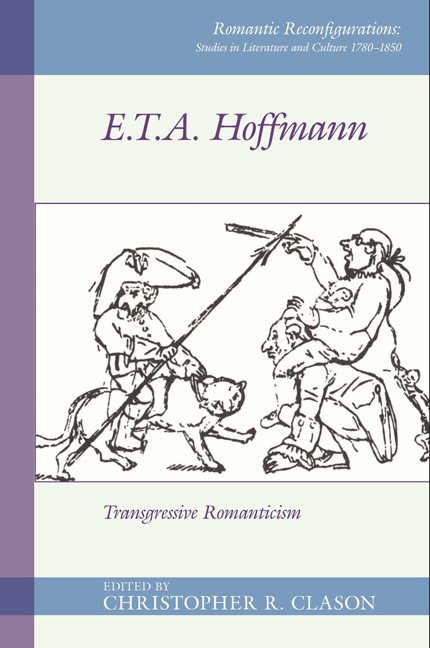Book contents
- Frontmatter
- Contents
- List of Figures
- Acknowledgements
- Notes on Contributors
- Introduction
- I Transgression and Institutions
- II Transgression and the Arts
- 4 E.T.A. Hoffmann and the Bamberg Theater
- 5 Transitions and Slippages of Mimesis in E.T.A. Hoffmann's “Der goldene Topf,” “Die Fermate,” and “Das öde Haus”
- 6 Transgressions: On the (De-)Figuration of the Vampire in E.T.A. Hoffmann's “Vampyrismus”
- III Transgression in the Märchen
- IV Transgression of Reception in Kater Murr
- Works Cited
- Index
4 - E.T.A. Hoffmann and the Bamberg Theater
from II - Transgression and the Arts
- Frontmatter
- Contents
- List of Figures
- Acknowledgements
- Notes on Contributors
- Introduction
- I Transgression and Institutions
- II Transgression and the Arts
- 4 E.T.A. Hoffmann and the Bamberg Theater
- 5 Transitions and Slippages of Mimesis in E.T.A. Hoffmann's “Der goldene Topf,” “Die Fermate,” and “Das öde Haus”
- 6 Transgressions: On the (De-)Figuration of the Vampire in E.T.A. Hoffmann's “Vampyrismus”
- III Transgression in the Märchen
- IV Transgression of Reception in Kater Murr
- Works Cited
- Index
Summary
Invited to Bamberg as musical director (Kappelmeister), Ernst Theodor Amadeus Hoffmann served variously as theater manager, playwright, composer, stage artist, and decorator through five seasons from September 1, 1808 to April 21, 1813. In his sketchbooks, stage designs as well as in his literary imagery and description, he replicated details of Bamberg architecture. Financial difficulties at the Bamberg Theater during these years required him to augment his income through musical instruction and to exert his abilities in most aspects of theatrical production including costuming and stage designs. In examining his stage designs I became especially interested in Hoffmann's setting for Verbrechen und Strafe, oder, Die Wiederkehr der Verstorbenen in das Reich des Lebens (Crime and Punishment, or, The Return of the Dead into the Realm of Life). All that had been previously documented concerning this play was that Hoffmann prepared for the production two sheets with set designs, and that it was listed in the Bamberger Theater-Journale for performance on December 26, 1811 under the direction of Franz von Holbein (Bamberger Theater-Journale, f18 recto).
In spite of the efforts of other scholars in retrieving further information about Hoffmann's involvement in the Bamberg Theater (Köppler 1–36; Lewandowski 1995 28–82; Dengler-Schreiber 46–67), no account of the play or playwright has yet emerged. I have identified the source for the play in a tale by August Lafontaine (Lafontaine 1800 91–139), and I will argue that Hoffmann himself adapted the tale for the stage. Among his adaptations one might compare Liebe und Eifersucht (Love and Jealousy) from August Wilhelm Schlegel's Die Schärpe und die Blume (The Sash and the Blossom, 1809, translated from Calderón's La banda y la flor). The distinctive characteristics of his stage designs provide primary evidence for Hoffmann's manner of adapting Lafontaine's tale.
The relevance of Hoffmann's stage designs to his subsequent narratological strategies has been observed by others (Rottenbach 324–25; Lewandowski 2009 174–98). As I will emphasize, Hoffmann favored in his representation of space on stage the same elements of liminality that were crucial to his narrative tales. Think of his frequent reliance on gates, doors, windows, and passageways and their crucial role in acts of witnessing, spying, gaining or hindering access.
- Type
- Chapter
- Information
- E. T. A. HoffmannTransgressive Romanticism, pp. 81 - 95Publisher: Liverpool University PressPrint publication year: 2018

